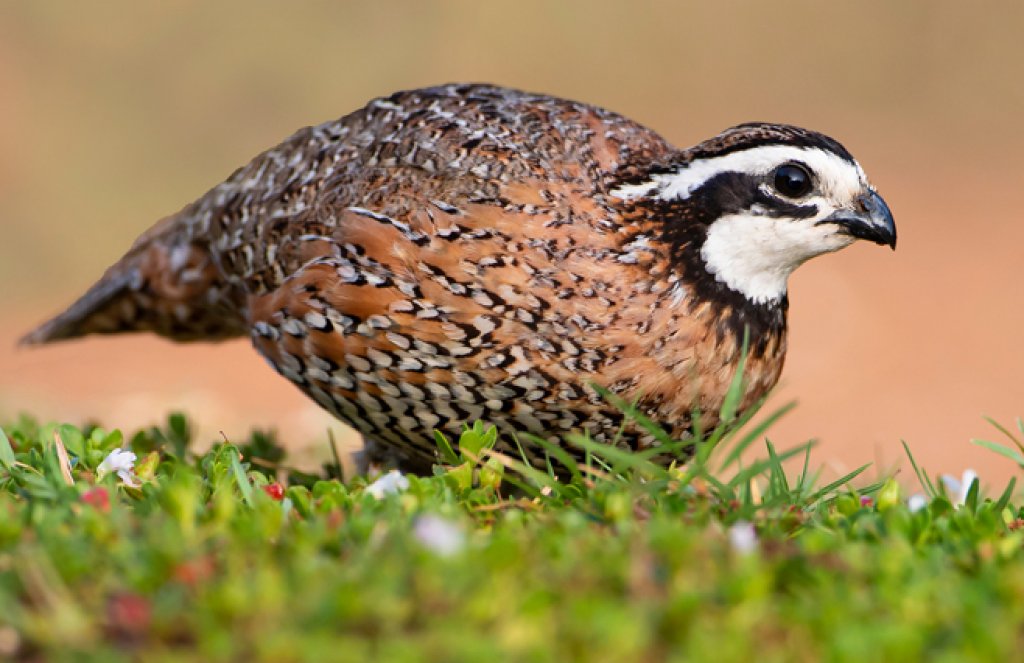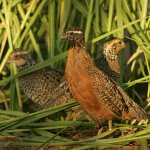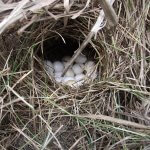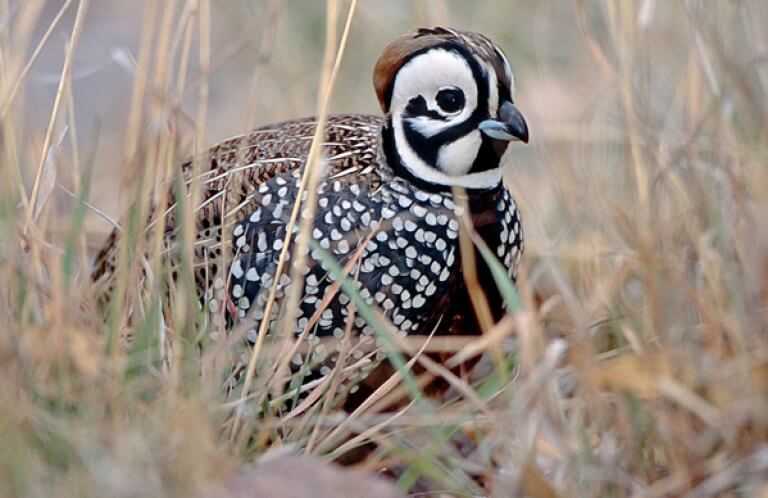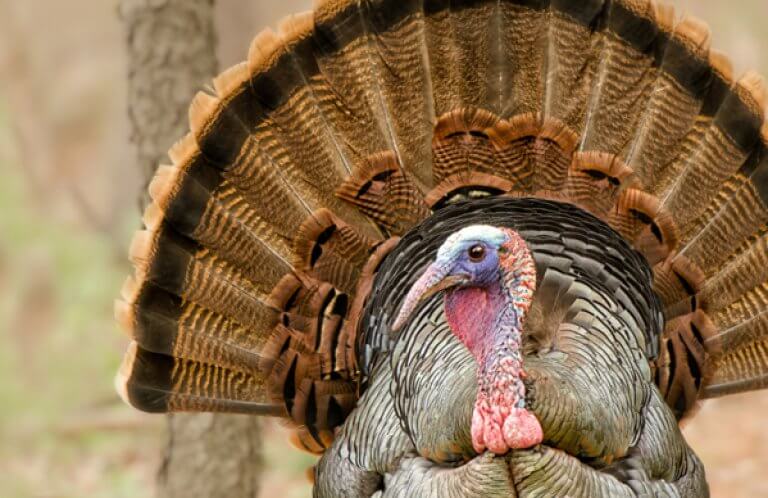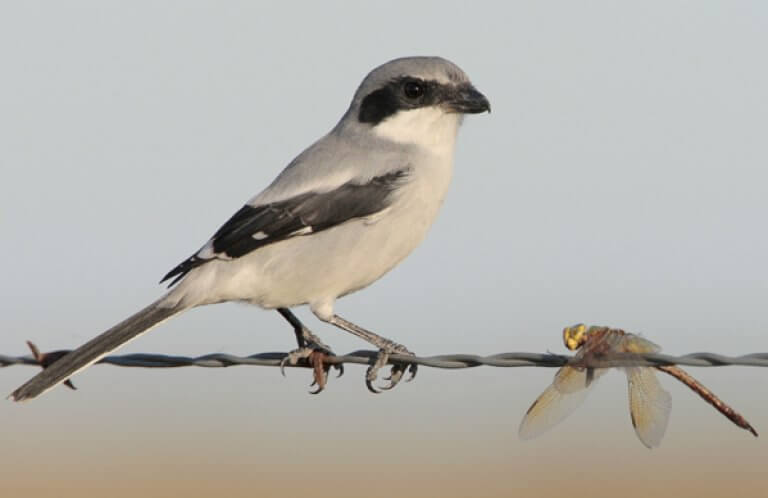About the Northern Bobwhite
The Northern Bobwhite, also known as Virginia quail or partridge, is a New World quail species in the same family as the Montezuma and Scaled Quails. Like its relatives, the bobwhite has a short, curved bill; a chunky, roundish body; and a short tail. It is a ground-dwelling species, preferring to walk or run, although capable of strong, short bursts of flight, particularly when fleeing from predators.
Northern Bobwhites are more often heard than seen, since they tend to stay within dense, low cover where their dappled brown-and-white plumage provides excellent camouflage. But sometimes, especially when calling in spring, males will occupy a highly visible location, such as atop a fencepost.
Although best known for its namesake whistle, the Northern Bobwhite also employs a wide variety of other calls for different reasons.
A Variety of Vocalizations
Since the Northern Bobwhite is a popular game bird, it has been well-studied over time, and found to have an extensive variety of vocalizations. This repertoire has been grouped into different categories comprising group movement, feeding, predator avoidance, and reproduction.
Both male and female bobwhites give a number of group movement calls (also called separation or scatter calls) that reunite separated pairs and coveys, or maintain contact while feeding. Adult bobwhites with chicks give a special soft call while using their beaks to direct the young ones towards food. When threatened by predators, the bobwhite's calls vary according to the nature of the threat (Is it coming from the ground or the air? Is it approaching or has it passed by?) Yet another set of calls are employed during the courtship, breeding, and nesting phases of this bird's life cycle.
Listen to a variety of the Northern Bobwhite's calls below!
Songs and Sounds
Probably the best-known of the Northern Bobwhite's calls is a clear, whistled “bobwhite”!
A group movement, or scatter, call:
Flight call:
Begging call of young bird:
Breeding and Feeding
Safety in Numbers
Each fall, Northern Bobwhites form groups, or coveys, of three to 20 birds. At night, these coveys roost in a close-packed, outward-facing circle with their tails pointing toward the center, probably to conserve heat and stay alert for predators. As a very social species, they stay in coveys until the beginning of nesting season each spring, when they begin to pair off.
Although seemingly monogamous during the nesting season, each member of a bobwhite pair may mate with several different partners, a strategy which ensures maximum genetic fitness and diversity. Both sexes work to build the nest, which is a simple scrape on the ground lined with leaves and grasses. These birds often weave dry grass or weeds to form an arch around the nest, which hides it from potential predators. In some populations, the female will leave the male to incubate and hatch one nest while she starts another.
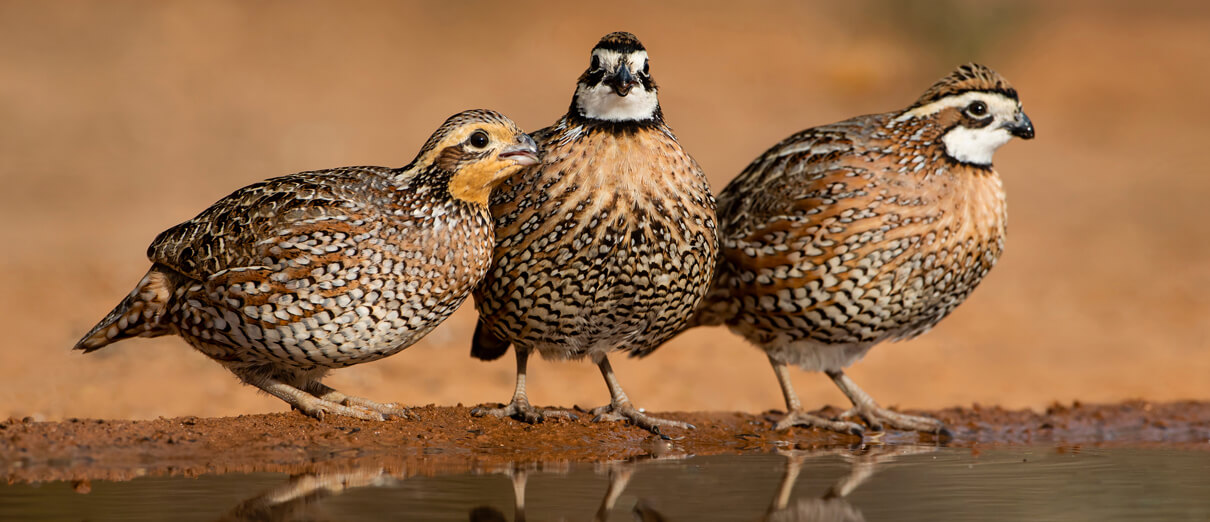
Female bobwhites lay large clutches of 12 to 16 eggs, which both parents incubate. The hatchlings are precocial (they emerge from the egg covered in down, able to walk, with eyes open) and leave the nest shortly after hatching.
Young bobwhites are fed and cared for by their parents for several weeks after leaving the nest. In a good nesting season and in suitable habitat, female bobwhites can raise several broods per year.
Like the Grasshopper Sparrow, Killdeer, and other ground-nesting bird species, adult bobwhites may perform broken-wing displays near nests or fledglings to draw predators away.
Dietary Dichotomy
The bulk of a Northern Bobwhite's diet consists of plant material such as leaves, buds, weed and grass seeds, berries, and grains. Depending on the time of year and the age of the individual, it will add protein to its diet in the form of small invertebrates such as grasshoppers, beetles, spiders, and crickets. Nesting females and chicks need the most protein for egg-laying and growth.
Like other ground-dwelling game birds such as the Wild Turkey or Greater Prairie-Chicken, Northern Bobwhites forage on the ground as a group, usually feeding in the early morning and late afternoon.
Region and Range
A Bevy of Bobwhite

Northern Bobwhites are widespread in eastern North America and south to southern Mexico. The species is also found in parts of the Caribbean and locally in a few areas of the Pacific Northwest. It's divided into a whopping 22 subspecies across its range, some of which were formerly considered to be separate species, including the Rufous-bellied Bobwhite and Black-headed Bobwhite. One subspecies, the Masked Bobwhite, is federally listed as Endangered.
Bobwhite are generally non-migratory, particularly where there is just the right habitat available. For this edge-dwelling bird, that means brushy meadows, overgrown fields, hedgerows, or open woods adjacent to native grasslands or agricultural fields.
Conservation of the Northern Bobwhite
Mysterious Decline
Populations of Northern Bobwhite plunged between 1966 and 2014, resulting in an overall decline of 85 percent, according to the North American Breeding Bird Survey. Partners in Flight considers the Northern Bobwhite as a “Common Bird in Steep Decline.” For years, an explanation for such drastic declines has been elusive. However, most biologists agree that multiple causes are to blame.
Habitat loss due to fire suppression, mechanization of agriculture, and fragmentation and loss of suitable habitat to urban development is probably the leading cause. But, the increased use of pesticides is also thought to be a culprit behind this steep decline—a worrisome trend also noted in other birds sharing similar habitats, including the Loggerhead Shrike.
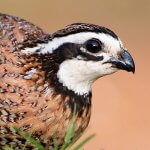
Help support ABC's conservation mission!
ABC continues to work for the regulation of harmful pesticides; our recent press release and updated report compiles the last decades' research on the harmful impacts of neonicotinoids, a widely used insecticide proven to have catastrophic effects on grassland birds such as bobwhite, the insect populations they depend upon for food, and nearby aquatic ecosystems.
Northern Bobwhites do respond positively and quickly to habitat management changes on working lands, and ABC-supported projects are focusing on bringing back the numbers of this bird. ABC's work with landowners in the Oaks and Prairies Joint Venture through initiatives such as Grassland Restoration Incentive Program (GRIP) has helped to restore habitat for Northern Bobwhite and other birds such as the Dickcissel. ABC also joins forces with groups such as the National Bobwhite and Grassland Initiative and the Central Hardwoods Joint Venture and other bird habitat joint ventures to create habitat for this species.
ABC is also advocating for measures to be included in the latest Farm Bill that have the best chance of helping U.S. grassland species such as the bobwhite rebound. The recommendations included in ABC's “Bird Saver" platform would help the Farm Bill channel funds designated for conservation to the programs that would make the biggest difference for grasslands.
Get Involved
Policies enacted by the U.S. Congress and federal agencies, such as the U.S. Fish and Wildlife Service, have a huge impact on U.S. birds. You can help shape these rules for the better by telling lawmakers to prioritize birds, bird habitat, and bird-friendly measures. To get started, visit ABC's Action Center.
Living a bird-friendly life can have an immediate impact on the birds around you. Doing so can be as easy as adding native plants to your garden, avoiding pesticides, and keeping cats indoors. To learn more, visit our Bird-Friendly Life page.American Bird Conservancy and our Migratory Bird Joint Venture partners have improved conservation management on more than 8.5 million acres of U.S. bird habitat — an area larger than the state of Maryland — over the last ten years. This is a monumental undertaking, requiring the support of many, and you can help by making a gift today.





































